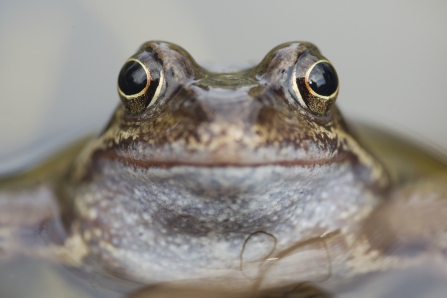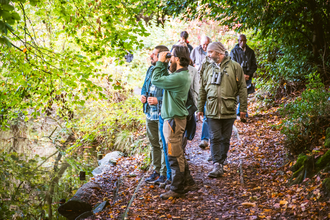
Credit: Katrina Martin/2020VISION
Unusual Frog Mortality
In recent years there has been an increase in reports of unusual deaths of frogs and toads, particularly in garden ponds. Most reports describe adult frogs dying over a period of several weeks. Typically they involve dozens and sometimes even hundreds or thousands of amphibians. The dying and dead frogs may or may not have obvious external symptoms (e.g. discoloured skin, ulcers, bleeding) but may appear lethargic and disorientated, particularly in and around the edges of ponds.
Amphibians play a vital role in natural food chains; during the spring and summer many thousands are killed and eaten daily to nourish predators such as foxes. It is also likely that, as with all wild animals, there are diseases to which they can succumb which need not necessarily give cause for concern. Contrary to some media reports, there is no evidence to confirm that there is a single disease responsible for the recent increased mortality, although this is a possibility. The situation is in fact extremely complex with many factors to be considered by experts in many fields. Unfortunately, there has been relatively little study of healthy frogs, and the study of wildlife disease is still in its infancy.
Many people take pleasure in watching frogs and enjoy the benefits that they provide in terms of garden pest control, and we should be vigilant for any unusual causes of death. Some of the more extreme cases of amphibian mortality cannot be explained satisfactorily, and will require more research before the cause(s) can be pinpointed precisely, and any actions or remedies, if appropriate, can be made.

Credit: Margaret Holland
Recognised causes of illness and death
Spawn
When frogs and toads lay eggs (spawn) early in the season, and especially in shallow water, there is a risk that a hard frost or freeze will cause the surface water and spawn to freeze over. Sometimes, only the layers of spawn near or at the surface will die, the lower parts being insulated to some degree, but often all of it is killed.
Spawn is sometimes laid partly or completely unfertilised, in which case it may become invaded with fungus and will in any case die shortly after being laid. Even healthy, fertile spawn may also succumb to fungal infection, especially in cold weather. The eggs of frogs, newts, and toads are an ambulant food source for a variety of animals, including ducks, moorhens, fish and newts. Toads, and their eggs and tadpoles, however, contain substances which make them unpalatable to many predators. Each adult female amphibian can lay hundreds (newts) and even thousands (frogs and toads) of eggs each year and it is perfectly normal to expect that many will fail to hatch.
Tadpoles
Tadpoles will often appear in huge numbers in ponds. It is unnecessary to "thin them out" and take them elsewhere. Tadpoles can survive at surprisingly high densities, and if they are crowded then the smaller or weaker ones will grow more slowly, die off, and be eaten, a process which is perfectly normal and has evolved to regulate fitness and numbers naturally. Dense tadpole populations will allow predators such as dragonflies and beetle larvae, newts, grass snakes and birds such as herons, blackbirds and robins to feed more easily, and it is unfair to deprive these animals of their bumper crop!
In shallow ponds, tadpoles will sometimes perish if the water dries up before they have metamorphosed (i.e. turned into froglets, toadlets or juvenile newts). In ponds which are brand new and/or relatively poor in nutrients, there may be little food available for tadpoles. This may lead to slower growth and later emergence, and can even force the tadpoles to overwinter in a pond (low water temperature can have a similar effect). Again, this is a natural occurrence in some ponds and is usually nothing to worry about. If many tadpoles are suddenly found dead, the cause could be an infection, a pollutant or oxygen starvation.
Little is understood about diseases of tadpoles, but some parasites and viruses are known to infect them. Changes in water quality, such as a sudden influx of chemicals due to run-off from the surrounding land, could well harm tadpoles, but little is known about this. There is evidence from other countries that increased solar radiation caused by changes in the atmosphere could harm tadpoles. However, if your tadpoles suddenly disappear, it may just be that they are being eaten, or that they may be hiding in the silt at the bottom, or a combination of these factors. Alternatively, tadpoles can sometimes metamorphose in a short space of time, which gives the impression of a sudden disappearance.

Credit: Mark Hamblin/2020VISION
Froglets
Frogs appear to be particularly vulnerable when they are transforming from tadpoles into froglets. At this stage, when they have gained all four legs but still possess the vestiges of their tail, they can neither swim as well as a tadpole nor hop as well as a terrestrial (land-living) frog, and are easy targets for predators. During the process of moving from the water to land, it is crucial that they can easily climb out of the pond. Unfortunately, in some garden ponds the sides are made too steep or inhospitable for the froglets to negotiate. There should be some way that emerging froglets can make their way out without having to cross hostile surfaces such as those that are very steep, highly absorbent, acidic, alkaline, or those that get very hot. Without this help, many may drown at the water’s edge. After leaving, they will not normally return to the pond for at least eighteen months. Birds and other carnivores may feast on froglets at edge of the pond as they summer.
Adults
Apart from "old age" (frogs can sometimes live to be more than six years old), adults succumb to a variety of predators. Owls, kestrels, bitterns, herons, weasels, otters, pine martens, badgers, foxes, grass snakes and pike will all relish frogs, and some will also take toads and newts. "Natural" predation by these animals, although alarming at first sight, will not decimate a garden’s frog colony, and is a sign that the food chain is functioning. In fact, predation may be beneficial in the long term by, for example, limiting population size and removing sickly individuals.
Sometimes, human-induced changes can lead to unfortunate consequences. For example, ponds near to a rubbish tip may be invaded by rats which may then prey on the amphibians. Frogs and toads have been discovered with many characteristic bite marks after intense rat predation, often with internal organs and tissues protruding. Some predators such as domestic cats and foxes may leave a proportion of their uneaten victims lying around, and some small mammals like stoats and weasels make hoards or "middens" as food larders. Adult amphibians may suffer from the same problem of steep pond edges as mentioned in the section on froglets, and toads seem to be the most prone to drowning.
Each spring, many frogs, toads and newts are killed crossing roads on their way to breeding ponds. In some locations, a large number of the population may be affected in this way, the result being a mass of dead and injured amphibians strewn across the road surface, particularly on warm rainy evenings in March.
Frogs may die whilst over-wintering at the bottom of ponds which freeze over, probably due to a build up of noxious compounds from plant and animal decomposition and a depletion of oxygen in the water. During the breeding season, female frogs and toads are occasionally drowned or die from the sheer exhaustion of the breeding activity. These are sometimes found clasped by one or more "unknowing" males. A number of diseases and parasites has been found in wild amphibians but little is known as yet about their impact on natural populations.

Credit: Mark Hamblin/2020VISION
Unusual frog mortality
Incidents where large numbers of adult frogs have died with no easily explainable cause seem to be on the increase. The vast majority of reports come from south-east England, and particularly Kent, Surrey, Sussex, London, Hampshire, Dorset and Essex. Some reports show that frogs die without any obvious external symptoms, whereas others may exhibit haemorrhaging, breakdown of limbs, lethargy, emaciation, lesions or skin ulcers, or a combination of these. In such cases, dead and dying frogs are found in or out of the pond, and numbers can reach several hundred per incident depending on the size of the population. Reports of dying frogs tend to peak in July and August. An incident of this size is unlikely to mean the end of the frog population for that area, but the detailed consequences of such outbreaks are, as yet, unknown. Mortalities of spawn and tadpoles have also been reported, but these have not yet been studied.
To date, the exact cause of unusual amphibian mortalities is not fully understood. Two types of virus-like particles, several bacteria, and high concentrations of some heavy metals have been found in dead frogs taken from some of these incidents. Other factors under consideration include contamination of amphibian tissues with other chemical pollutants and other environmental changes.
At present it is not known whether any one or a combination of these factors is responsible for the deaths seen. The term "red-leg" has often been applied to frogs which had certain obvious external symptoms such as open sores and haemorrhaging, and this is thought to be associated with invasion by bacteria such as Aeromonas hydrophilia. However, red-leg is a name for a generalised set of haemorrhagic symptoms rather than a specific disease, and is not proven to be the primary cause for concern. It is thought that this condition may arise after an initial infection or affliction by some other pathogen, pollutant, stress-inducing agent or other factor which is the real root of the problem. This theory is supported by the fact that many frogs in these incidents die with no apparent external symptoms. In other words, "red-leg" may be an additional complication to an already serious condition.
As it is not yet known for sure what is to blame for these deaths, it is difficult to know how to control the disease, or even whether such a course of action is desirable. If it transpires that the problem constitutes a natural disease of frogs in Britain, then we may have to accept that this is a normal facet of their ecology. It is a feature of nature that the hardship experienced by an individual animal may in fact benefit the other animals in the population. For instance, if one animal dies from starvation due to competition for low levels of prey, or indeed from a disease, this may in fact increase the prospects for others in the area by effectively making more prey available, or by removing animals with ill-equipped immune systems. If, however, the results of the Frog Mortality Project point to a foreign (i.e. "unnatural") disease which has spread to our frogs via, for example, imported coldwater fish or exotic amphibians, then consideration of control or intervention would seem prudent.

Credit: Vicky Nall
What should I do if I observe unusual frog mortality?
Report incidents of unusual mortality by writing (enclosing a photo of your frogs and pond if possible) to: Froglife, White Lodge, London Road, Peterborough PE7 0LG. This will provide us with invaluable information and help us to monitor the course of the phenomenon.
Is there anything I can do to treat or help the sick frogs?
Unfortunately, we are presently unable to give advice on how to treat frogs which appear to be ill (as the cause of sickness is unknown), so the current guidance is to leave them alone. Individual animals can be taken to a veterinary practice for treatment if you believe they are suffering unacceptably, but this will probably not remedy the source of the problem. Some frogs may recover from the affliction and bolster local immunity to any prevalent disease.
What should I do with dead frogs?
Dead frogs can be buried or incinerated. As with dead animals, care should be taken not to come into direct contact with the carcasses.
Will frogs return to the pond after unusual mortality?
Our information shows that the effect of mass mortalities on frogs in subsequent seasons is unpredictable; sometimes frogs return the next year and appear to breed normally, while at some sites the frogs seem virtually to disappear (at least in the short term).
Are tadpoles or frogspawn affected too?
Mass die-offs of tadpoles are not uncommon (see above) but it is difficult to tell whether the cause is the same as that for the adult mortalities. Certainly, some people who report dead frogs also observe spawn failure.
Is there any danger to people, pets or fish?
There is no evidence that people or pets can be affected. Many reports of dyimg frogs have come from ponds also containing fish which appear to be unaffected. However, certain bacteria which are naturally very common in pond water may affect fish, but the presence of frogs will probably not influence this. There is absolutely no need to move frogs because of disease risk to other animals.
Should I isolate frogs from my pond if I suspect a disease?
This is not advised because at present we cannot give advice on how to treat them, and as frogs are difficult to keep healthy in captivity, it may be best to leave them alone until the proper studies have been conducted.
Should I clean out my pond?
There is no evidence that cleaning out the pond or changing the water will help to limit the deaths, although too many dead frogs could foul the water and cleaning out may then be desirable.
What if tadpoles and froglets are dying in my pond?
It could be that froglets are drowning as they cannot easily leave the water. A good way to remedy this is to provide "ramps" of bark, wood, moss or vegetation at the edge of the pond. In the long term it is best to ensure you have plenty of marginal plants to provide cover for emerging froglets
What if the pond freezes over in winter?
If severe weather causes the pond to freeze for more than a couple of days, sink a bucket of hot water through the ice, or float a football on the surface to make a hole for the pond to "breathe", allowing oxygen in and noxious gases out.
Is it necessary to feed tadpoles?
Normally, no. There should be enough algae and decaying material for them in the pound naturally, and it is better to let them feast on this rather than risk fouling the water. The only time it may be useful to add food is in a newly created pond with little plant growth, in which case commercially available rabbit pellets or fish flakes can be added in small amounts.
Will fish and frogs coexist happily?
Although in many garden ponds, frogs and fish get on quite successfully, frogs will always do better on their own, as fish will make a meal of their spawn and tadpoles. Generally, fish tend to benefit as they gain a large food source, and sometimes they can eliminate frogs from the pond. Male frogs occasionally latch on to fish during the breeding period, mistaking them for female frogs, but this is rarely a problem.
Should I remove potential nature predators such as grass snakes or hedgehogs from my garden?
No. It is perfectly normal to frogs to fall to other animals, and we should not interfere with nature’s way of making sure there is enough food to go around. Natural predators will not wipe out whole colonies of frogs, since this would then leave them with an empty larder. You can assist the frogs by enhancing the habitat with rockeries, long grass and other places where they can hide.



